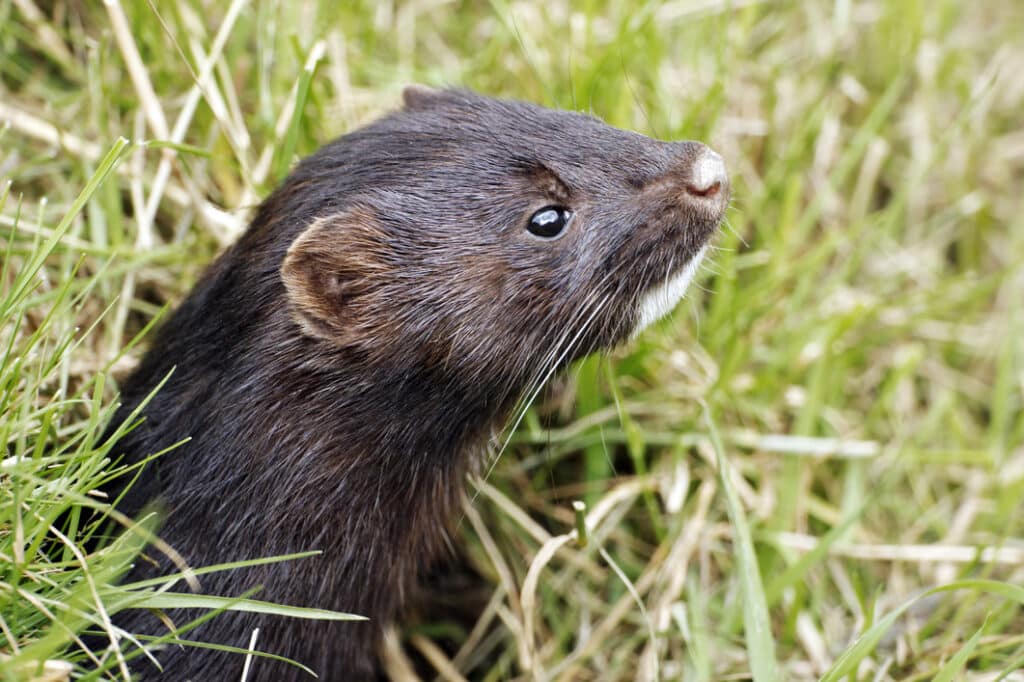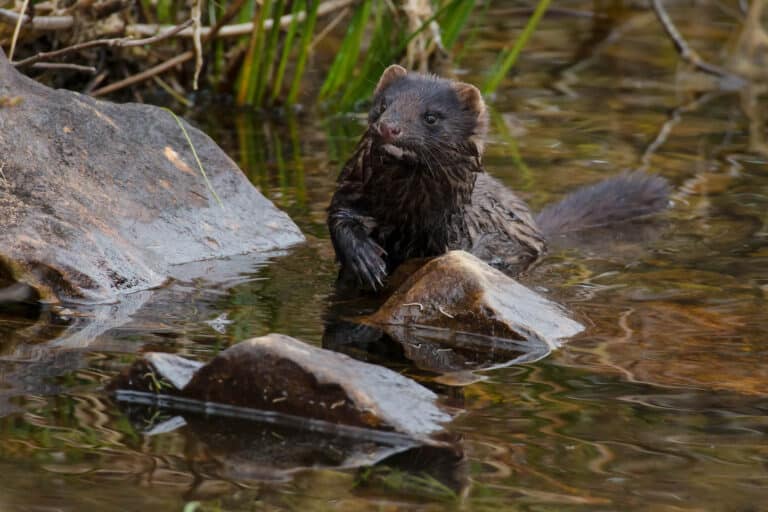Facts about the American Mink
Scientific name: Neovison vison
At a glance
- Brought here in 1929 by fur farmers and released into the wild by animal activists in the 1950s.
- Mink numbers appear to be controlled by the return of Otters.
- Mink numbers in Britain could have fallen by as much as 45% in 20 years.

Few animals found in the UK are quite as polarising as the non-native American Mink.
Clearly beautiful animals, they were brought here in 1929 by fur farmers and only released into the wild in the 1950s by activists who were quite rightly appalled at the conditions the animals were kept and slaughtered in. However, from a small base population mink – bold, inquisitive, aquatic animals – have used waterways (and a lack of Otters) to expand right across the country leading to a severe loss of biodiversity in some places.
Despite concern about their potential impact, while mink barely had a foothold in Britain (and Ireland) they appeared to be doing little serious damage, However, as numbers built and they expanded in to more areas at least two serious impacts were recorded.
Some seabird colonies on offshore islands within the swimming range of mink began to suffer severe losses of both adult and young birds. Black Guillemots, which nest sparsely in scree slopes, seem to be very vulnerable. Perhaps more significant was the effect on Water Voles, which became a key part of the minks diet. Easily found by mink as they searched strips of the riverside habitat voles are adapted to, Water Voles proved very vulnerable and their population plummeted in the 1990s.

Serious attempts have been made to permanently remove mink from river systems in an effort to restore Water Vole populations, which are still one of our most threatened native mammals.
It’s almost impossible to accurately say just how many mink there now are in the UK, but, based on reported sightings, the Mammal Society suggested in 2020 that mink numbers in Britain could have fallen by as much as 45% in 20 years. Ironically that may because of a catastrophic decline in its main prey items – Water Voles and rabbits.
While its clear that minks have impacted Water Vole, it’s also true to say that during the same period there has been massive wetland habitat loss, degradation and fragmentation due to damaging riparian management (for example ‘hard’ river engineering techniques), and over-grazing by livestock.
Interestingly, while mink ‘control’ to help voles has focussed on trapping and shooting, evidence began emerging in the early 2000s that part of their decline may be due to recovering populations of Otters, which crashed to close to extinction in the 1960s and 1970s. Large numbers died of poisoning from Dieldrin, a now banned organochloride used as a sheep dip that bioaccumulated in the fish that Otters ate. Researchers at Oxford’s Wildlife Conservation Research Unit found a significant relationship between the decline in mink signs and the increase in Otters. They suggest that the growth in Otter numbers – which is linked to the removal of hunting pressures and the return of fish to cleaner rivers – may in turn be driving the reduction in mink.
Otter hunting was banned in 1978 in response to the collapse in Otter numbers, and Mink hunting (at least with hounds) was banned by the Hunting Act 2004. However, it does of course still take place. Otter packs switched to hunting mink, and hunters (with occasional tacit support from ‘conservationists’) now try to claim that they are aiming to support Water Voles. The truth is that besides it being illegal, hounds don’t distinguish between mink and otters so will chase the latter when they find them, and groups of hunters crashing through waterside vegetation actually damages the habitat of the very voles they claim to be helping.
As always, there is rarely one simple answer to biodiversity loss, no matter how hard landowners and wildlife criminals in particular might try to suggest there is.
- Anyone seeing a ‘mink’ pack hunting is urged to immediately report them to police, a local sabs group, or hunt monitors.
